Many people seem to hold the misconception that being able to speak two languages automatically qualifies you as a translator. It could not be further from the truth. Literary translation is not merely about words; the translator does not mechanically work as a bilingual dictionary. Translating, like writing, is a creative activity; a translator needs to think about readership, target language and target culture. Domestication (a term coined Lawrence Venuti) and the possibly less pejorative-sounding cultural context adaptation (a term coined by Göte Klingberg) are tactics which allow translators to make necessary changes to accommodate the target audience’s cultural and linguistic background. This may sound like the translator is taking liberties, but it is needed to allow for a certain flexibility if the translated text is to appeal as much in its target language as it did in its original language. This is particularly vital when targeting younger audiences who will not have the experiences adults will have allowing them to put their reading into an international context.
Then, of course, when translating picturebooks, translators need to ensure that translated text and artwork work together too.Their unique relationship is crucial and often neither make sense in isolation of the other, with the artwork always adding extra information that cannot necessarily be included in the text. According to Riitta Oittenen (see further reading), “when a book in translation is illustrated, the pictures bring along a new point of view. The visual is the context of the words, and the other way round: when translating picture books, it is the totality of the verbal and the visual that is translated”.
One would think that illustrations might help the translator, by giving context, supporting translation. However, this is often not the case. Consider The Gruffalo for example – the rhyming text relies heavily on the descriptions of the Gruffalo; when translating this into another language, the translator will be limited in the translation by the artwork. In the case of the French translation, this has meant that the text has lost its rhyming:
His eyes are orange
his tongue is black;
He has purple prickles all over his back
becomes
Ses yeux sont orange,
sa langue est toute noire,
son dos est couvert d’affreux piquants violets !
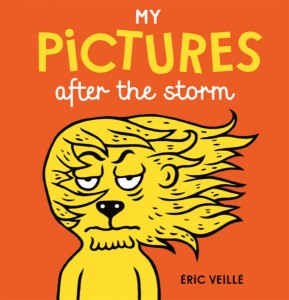 Bearing all this in mind however, you would be forgiven for thinking that translating an ‘imagier’ ( a ‘word book’ – interesting how the French term highlights the visual element of it while the English highlights the text) is going to be quite straight-forward; after all the text comprises of single words or idioms, how hard can it be?
Bearing all this in mind however, you would be forgiven for thinking that translating an ‘imagier’ ( a ‘word book’ – interesting how the French term highlights the visual element of it while the English highlights the text) is going to be quite straight-forward; after all the text comprises of single words or idioms, how hard can it be?
Well, pretty hard actually, and this is illustrated perfectly by My Pictures After the Storm (Gecko Press) written and illustrated by Eric Veillé and translated by Daniel Hahn, a clever ‘before and after’ word book, with each double-spread focusing on a loose theme (lunch, the beach, a new baby etc); on the recto (left) spread ‘My Pictures’ which focus on the theme, while on the verso (right) the same pictures transformed by various, often calamitous, circumstances. These contrasts create a very humorous narrative, which encourages young children to fill the gaps, and to consider cause and effect. The bright primary colours and bold drawings emphasise the comic component, with a hint of deadpan humour which will delight adult readers also. The English text includes rhymes and play of words, which might make one wonder how this compares to the original text.
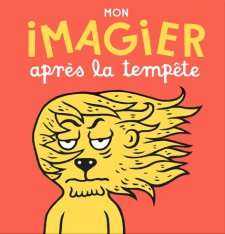 A closer look at the French original, Mon imagier après la tempête, published by Actes Sud Junior, showed some fascinating alterations had been made, and I was delighted that Daniel agreed to answer a few questions on his translation as a result. Daniel has extensive experience of translation, both for adults and children and I was keen to find out about how this particular translation came to life.
A closer look at the French original, Mon imagier après la tempête, published by Actes Sud Junior, showed some fascinating alterations had been made, and I was delighted that Daniel agreed to answer a few questions on his translation as a result. Daniel has extensive experience of translation, both for adults and children and I was keen to find out about how this particular translation came to life.
Hi Danny, Many thanks for agreeing to answer a few questions about My Pictures After the Storm. I would first like to look at the theory of translation and how this translation might fit into this. Oittinen states that she considers translating “as rereading and rewriting: every time a book is translated, it takes on a new language, a new culture, and new target-language readers”. You have extensive experience of translation, both for adults and children; do you agree with Oittinen’s statement, and how does translating for children differ from translating for adults?
Yes, I think most of this is uncomplicated; the only tricky bit is the notion that a book in translation “takes on a new culture”, which is also perhaps where the key differences are between translating for children or adults; there’s no reason, I think, to assume that children have a problem with understanding other cultures they’re presented with, but we can certainly assume that on average they know less about them simply because they haven’t been around for quite as long as we old people have. So do I find myself changing cultural details slightly more for children, or at least explaining them along the way (where I might assume an adult would recognise them without my help), to bring the reader’s experience closer to the experience the author intended.
Of course, translating picturebooks brings a unique set of challenges, because the intertwined relationship between visual and verbal narratives is what creates the overall meaning. As Oittinen states, “when a book in translation is illustrated, the pictures bring along a new point of view. The visual is the context of the words, and the other way round: when translating picture books, it is the totality of the verbal and the visual that is translated.” Does this make translators’ task more complex?
Indeed, translating picture books means you’re doing something more than just translating text – you can’t simply extract the words, translate them, and then dump them back onto the page and hope they’ll work. They need to be wired in properly, because they need to run smoothly together for the book to work; all the more so in the case of this book, where in so many cases the illustration is itself there to illustrate a pun – you then need to come up with a piece of text (usually condensed to a couple of words) for which this would be an apt illustration.
Going back to people’s assumptions about translation in general, many would take for granted that as My Pictures After the Storm is a type of visual dictionary (or ‘image book’ if we were to translate the French literally) and that there is therefore no narrative so to speak, the job of the translator is made much easier. Is it?
Ha! I’ve worked on about fifty books so far, and word for word, this one was undoubtedly the hardest. If it were only a visual dictionary and nothing more (picture of a ball with the word “BALL”, picture of an apple with the word “APPLE”, picture of a lion with the word “LION”) it would have been easy enough. But…. no.
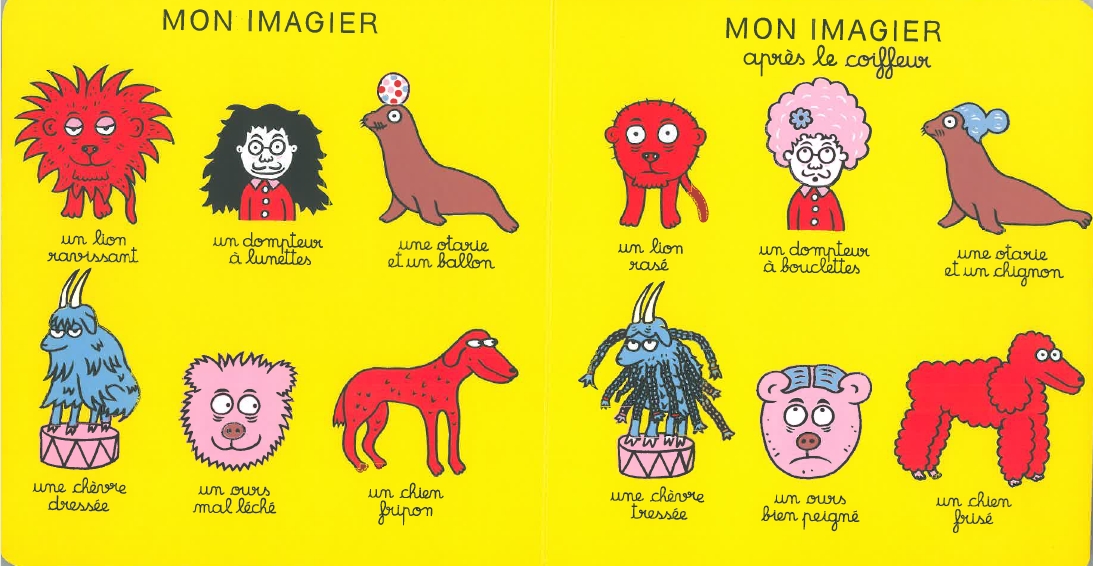
So translation depends a lot on its target audience, particularly when it comes to children. But I assume that publishers are also aware of saving money, and as a result many translations into English must have to ‘work’ for several anglophone markets; this means not only language but also cultural markers must be recognisable within several cultures (New Zealand, Australian, British, American etc). This why, I assume, there are pictorial changes in the ‘My Pictures After the Baby’ for example: une couche becomes a rattle and une tétime becomes a bottle:

How difficult is this to juggle, as a translator, and how are such changes motivated?
Usually the issue doesn’t arise, actually, either because publishers will split editions across different markets or because they assume their readers can manage the odd word/spelling in a different English; it’s slightly more tricky with children’s books, so apart from some spelling conversations (woolly or wooly?) one of only two pages where we asked the author for new illustrations was on the new-baby spread, where there was just no way of finding a “neutral” word for dummy/pacifier or nappy/diaper, which would be recognised by Anglophone children everywhere. (Doesn’t have to be used everywhere, of course, just recognised.) . We wanted to change as little as possible, and just work hard to find solutions (clever or otherwise) to most problems. The easiest thing would have been to change an awful lot – or, for that matter, start a lot of these pages from scratch, writing rhyming/punning text and then getting it illustrated (infinitely easier that way!) but we ended up only asking Eric to change things that simply *could not* be made to work in English. The “after a cold” page plays on the way we can’t say m and n sounds with a blocked nose; there were a couple of French words that translated into English however hard you stare at them don’t have any m’s or n’s. So we replaced a couple of those. (In one case, we just recoloured the carrot to look like a parsdip. Sorry, parsnip.)

This brings me nicely to my next observation when comparing the two texts: there are several cultural adaptations of the text only; I guess books for the youngest readers cannot easily do without domestication when it comes to words, particularly as the target audience are still acquiring language. For example, ‘compote’ becomes ‘jam’ in English version. Compote (stewed fruit) is a stable food for babies in France and though it is sometimes used in the English language, this is not one young children would know. How do you decide what can be more or less literally translated and what needs adapting?
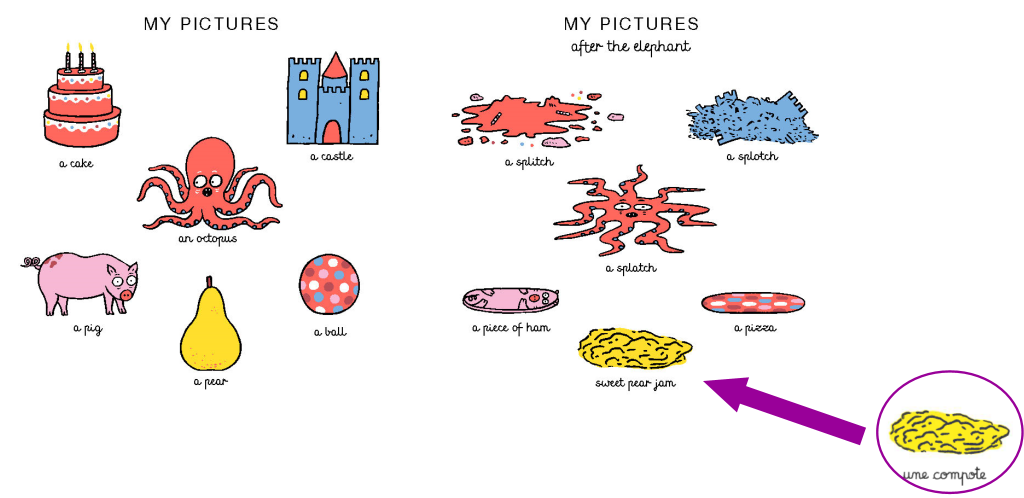
Only the tiniest number of English children would know what “compote” is, and I didn’t see any reason why we’d want to replace something that seems normal (“domestic”, even) to readers with something entirely alien to the new readers. But also… one of the reasons I’m slightly cagey about using the language of translation theory is that it so often suggests that decisions are based on one-dimensional strategy, and actually there are a thousand things at play in any even moderately interesting text – in this case, the question I asked myself was not “Is this to be a domesticating translation?” but “What can I write here that will be a close-enough translation of the French AND be comprehensible to my English readers AND be a plausible caption for this particular unchangable illustration AND also what rhymes with ham?”
Quite, theory and practice are very different things!
I will get back to rhyming in a moment but first I want to ask about something which, as a French native, surprised me. In the Surprise (Christmas) spread, the slippers have remained unchanged, yet to me they lose their significance: in France, we don’t hang stockings, but we leave our slippers under the tree. This bothered me, because to me this is an important cultural marker, in fact one of the French Christmas traditions we have retained in the Library Mice household,where French, Irish and British cultures collide and compete. Why leave this when others, less conspicuous to me, were amended?
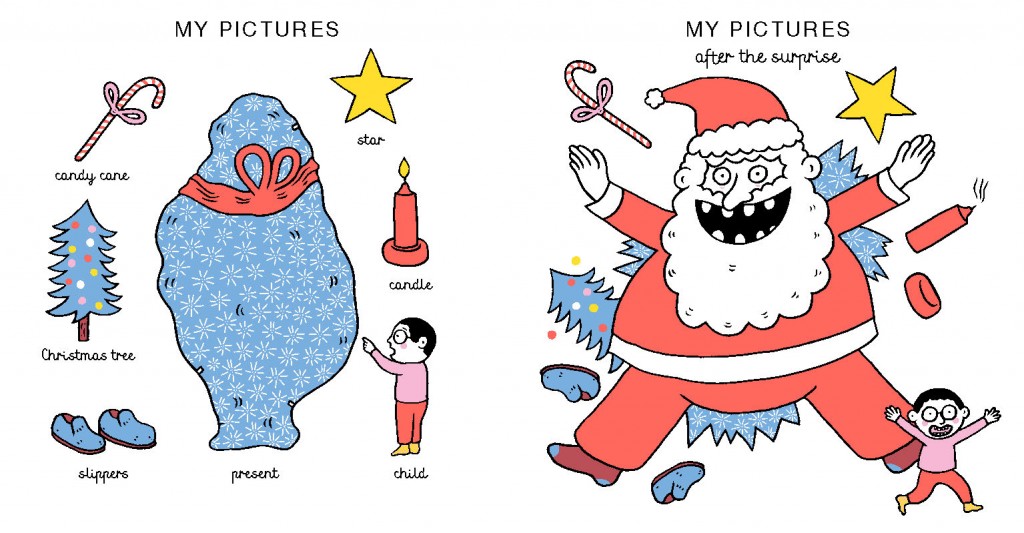
This goes back to the previous question – we only changed when we had to. Not when we thought there was a cultural loss, but where making the page work without changing it was impossible. A pair of slippers doesn’t do the same for an English reader as for a French, but it still works as part of the tableau (a word I’d probably change in an Anglophone picture book).
Yes, I’ll concede I am probably looking at this with slightly skewed eyes!
Going back to the rhyming then, Veuillé’s original text is heavily influenced with play on words and sounds. The ‘cold’ double-spread is an obvious example, and there are pictorial changes to allow for the translation to make sense as you have mentioned already, but there is also rhyming and play on words throughout the text. How do you strike the balance between trying to emulate the playful text while retaining some sense in the translation?
I suspect you will be the only person in the world who will look at the English text alongside the French text; most people (you know, *normal* people, not like you and me) won’t look at the transition but only the finished product; so most importantly my job is to make something that works – which is to say, something where the English text and the pictures work together. So in many cases the English text is not properly speaking a “translation” of the French text, but an attempt to create a new text that has the same effect, in the same spirit. My “ice cream gone!” is clearly not a translation of “une grimace” in any sensible way. I’m sure many of the choices that went into the original were only made because French *happens* to let the author do these things (the reason Dad turns into a fork rather than a spoon or a knife is *only* because in French the words fâché and fourchette happen to be similar, so he didn’t have to contort himself to make the joke work) so the literal meaning is pretty incidental.
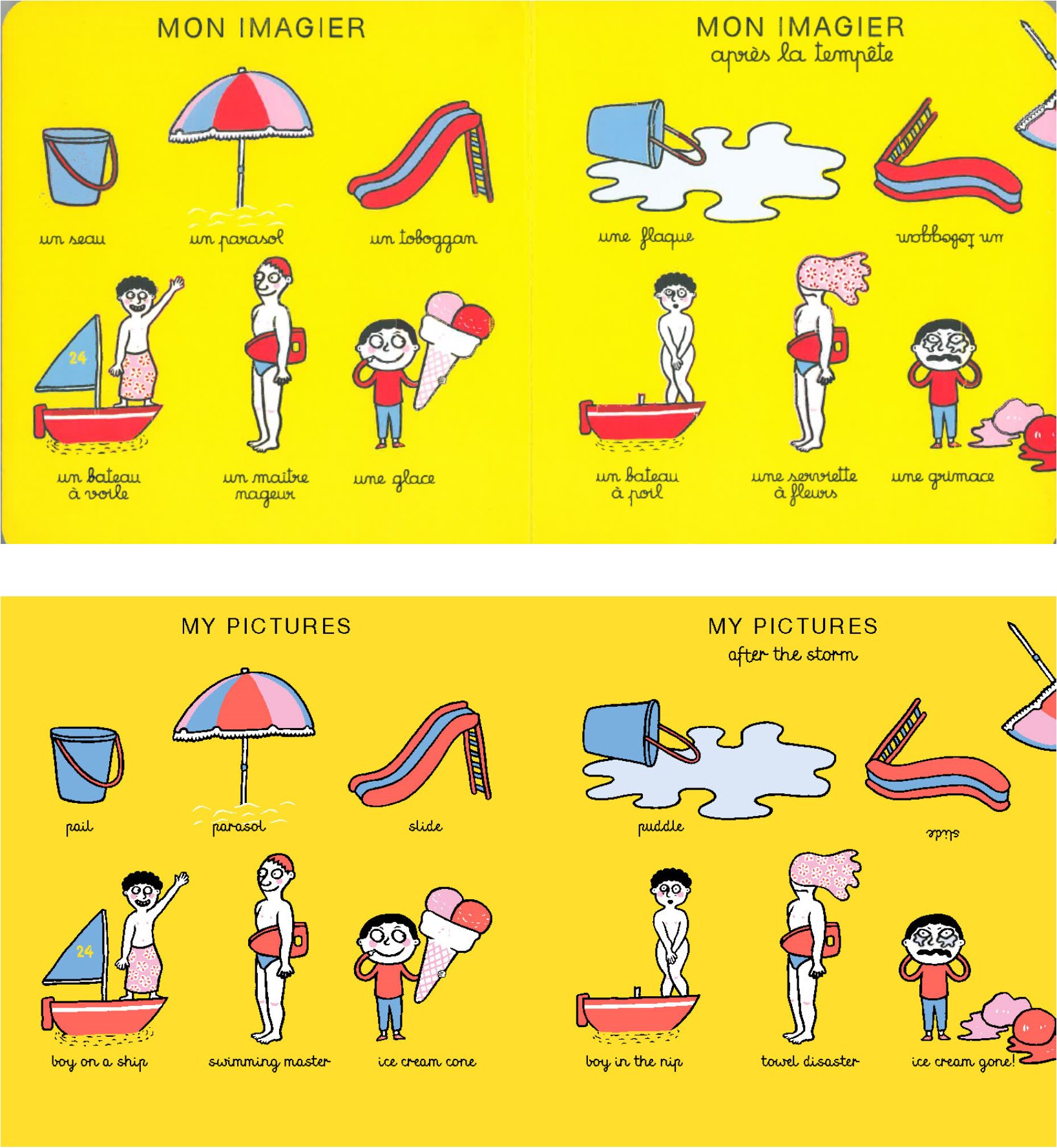
Thank you so much Danny for taking the time to answer my questions. I have found looking at both texts fascinating!
—-
My Picture after the Storm is released on 6 April. It is written and illustrated by Eric Veillé, translated by Daniel Hahn and published by Gecko Press.
You can purchase a copy here.
Riitta Oittinen ‘Where the Wild Things Are: Translating Picture Books.’ Meta. Vol 48.1-2 (2003): 128-141.
‘Translating the Visual’





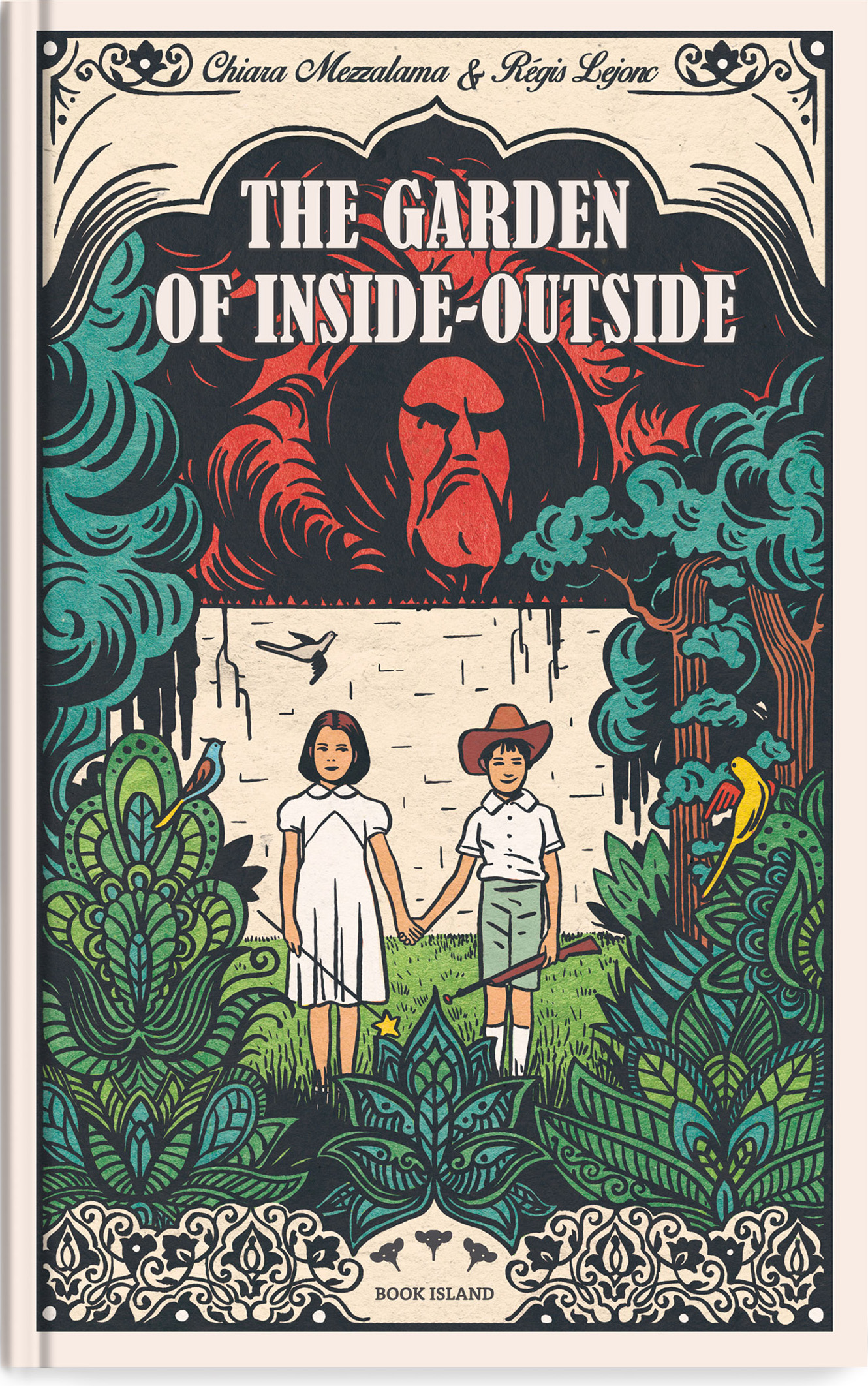

Thanks for this post ! Author, illustrator and translator have to be a real true team to make a good work. I like “image books” like this one, with a little second degree joke. A bad translation would not make it “spicy” at all.
Do you know Nadia Budde ? She is a german author illustrator. Her books are a good example of this: un deux trois et toi in french and one two three me in english. Translation has to cope with the musicality, sense of humour or it does not work at all ! They succeeded.
[…] experience. If you think it’s easy to produce bilingual picture books, think again! (Or read this piece by Daniel Hahn.) When the aim is to produce parallel texts in Chinese and English for a picture […]